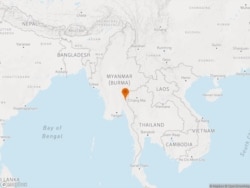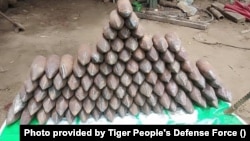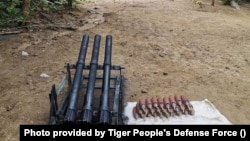Opposition People’s Defense Forces in Myanmar are battling the ruling junta’s military with locally produced weapons, members of the PDF told VOA in recent weeks.
The PDF members, mostly students and farmers with no previous weapons manufacturing experience, said they figured out how to make the weapons from YouTube and from each other.
Most opposition troops are said to rely on these improvised weapons.
Some opposition armed groups in central Myanmar and in Kayah state, along the country’s eastern border with Thailand, have been producing and using handmade weapons, including rocket launchers, inflicting heavy casualties on junta forces.
The Tiger People’s Defense Force in Sagaing region’s Pale township has produced 15 rockets with a range of around three miles. Initially the group produced rudimentary rifles, bombs and mines, then moved to producing rocket launchers and ammunition within six months.
“We made 100 single-shot rifles and shared them with other groups in Sagaing region and produced 300 rounds for rocket launchers. All of those weapons are being used in battle,” said Bo Than Chaung, head of the Tiger People’s Defense Force information and weapons production team.
Another resistance unit, the Karenni Generation Z, active in Kayah and southern Shan state, has been producing 130 mm, 70 mm and 55 mm mortars since March. Kalay Bo, the unit’s spokesperson said it costs between $50 and $80 to make a mortar.
Karenni Generation Z can produce 20 rounds for 130 mm mortars per day. However, it must change locations whenever the junta finds out where it is operating, and it faces raw material and, most importantly, financial issues.

“At first, we were able to produce homemade hunting rifles to fight the military. However, we could not resist with these guns when the junta forces used automatic weapons, long-range artillery, jets and helicopters. That’s why we developed more advanced weapons to fight the military,” Kalay Bo said.
Armed resistance movements erupted across Myanmar shortly after the military cracked down on peaceful protests of last year’s military coup. Since then, the armed People’s Defense Forces have emerged. However, not all the groups are working together under a single command. The opposition National Unity Government has said 257 battalions have been established under the command of the NUG defense ministry and more than 500 PDFs are affiliated with the ministry.
Some PDFs are based in areas in Kachin, Kayah and Karen states in the east and Chin state in the west that are under the control of armed ethnic organizations that have been fighting for autonomy for years. Those units are receiving arms support from the Karen National Union, Kachin Independence Organization, and the Arakan Army – themselves ethnic organizations – as well as the NUG.
However, obtaining weapons for fighters in central Myanmar is difficult because of transportation difficulties and lack of funding. According to the resistance chapters, it costs at least $3,000 for an automatic machine gun on the black market. Because of the lack of weapons and insufficient funds, opposition groups have turned to producing weapons themselves.
One group, the Anti-Dictatorship People’s Revolutionary Army, or DPRA, with nearly 1,000 fighters, which operates mainly in Sagaing but also has launched guerilla attacks in the cities of Yangon and Mandalay, learned the technique for producing rockets from its ally, the Kani Guerrilla Force in Sagaing. Depending on the availability of raw materials, the DPRA said it manufactures 20 rocket launchers, 30 60 mm mortars, 20 roadside bombs and 30 8 mm rifles a month.
“We receive 10 million kyats [$5,000] a month from public donations and most of it is used for weapons production,” Linn Nway, a senior member of the organization, told VOA.
The DPRA estimates production costs at $175 for a roadside bomb, $35 for each 60 mm mortar and 8 mm rifle round, $75 for a rocket with a range of between three and five miles. “It takes three months to produce a rocket,” Linn Nway said.
Some small opposition groups made up of around 50 members are incapable of combat with the junta forces because of a shortage of weapons and manpower. The groups depend heavily on their production of mines for guerrilla warfare against military convoys, bases, banks and buildings.
“Although we cannot fight with the junta forces, they are afraid of entering into the villages. They were ambushed by our group, which inflicted heavy causalities because of landmines we planted,” said Bi Lone, a leader of the Black Wolf Defense Force in Sagaing’s Monywa township.
Most of the PDF-produced weapons are rudimentary and insufficient to defeat the well-armed junta forces.
Many groups can only produce single-shot guns that can only be loaded with one bullet.
“Each time we shoot, we have to insert another bullet to shoot again,” Bo Than Chaung said.
Opposition groups say the lack of military-grade raw materials and of arms-making experience has cost lives and caused injuries and loss of materials when manufacturing weapons. In October, some members of Black Wolf Defense Force were seriously injured and a large quantity of raw materials, plus fighters’ property, including uniforms were destroyed in an explosion while making explosive devices, Bi Lone said.
Another issue facing the opposition groups is obtaining raw materials, such as iron pipes, lead, and gunpowder, as the military regime has restricted the transportation of metal, including iron and steel, into Sagaing. Goods coming into Sagaing are subject to strict inspections.
“We can manage to get iron, mostly we face shortage of gunpowder imported from India and the Thai border. We cannot make homemade bombs without it,” said Lin Nway. Under these circumstances, the price of raw materials has tripled, and it costs more than $150 for 35 grams of gunpowder.
Opposition groups say only 10% of their troops can be armed with commercially produced weapons, and the rest rely heavily on locally produced weapons. The groups are heavily dependent on public donations and selling their belongings to raise funds for weapons production, however, production can fulfill less than 50% of requirements. Under these circumstances, the opposition forces all say a lack of financial support is the biggest problem.
“We need at least 10 million kyats [$5,000] per month, however, the donation we normally receive is around 5 million kyats [$2,500],” said Bo Than Chaung. The group is working under the NUG but has not received any support so far.
“I hope, one day we will get weapons from NUG,” he added.
On July 9, the NUG’s defense ministry publicly shared its spending for military affairs. As of May, of the $44 million in military spending, about 63% went for weapons, ammunition and military operations and 22% went for weapons production. The NUG has said it needs at least $10 million a month to support the fighting forces.











